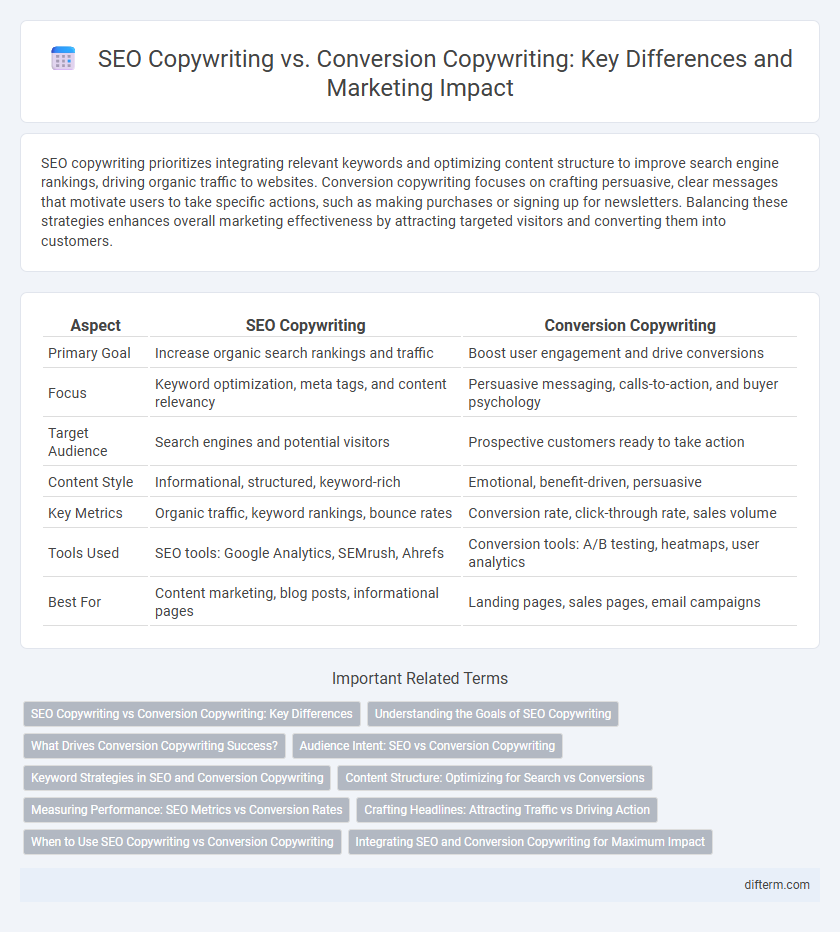SEO copywriting prioritizes integrating relevant keywords and optimizing content structure to improve search engine rankings, driving organic traffic to websites. Conversion copywriting focuses on crafting persuasive, clear messages that motivate users to take specific actions, such as making purchases or signing up for newsletters. Balancing these strategies enhances overall marketing effectiveness by attracting targeted visitors and converting them into customers.
Table of Comparison
| Aspect | SEO Copywriting | Conversion Copywriting |
|---|---|---|
| Primary Goal | Increase organic search rankings and traffic | Boost user engagement and drive conversions |
| Focus | Keyword optimization, meta tags, and content relevancy | Persuasive messaging, calls-to-action, and buyer psychology |
| Target Audience | Search engines and potential visitors | Prospective customers ready to take action |
| Content Style | Informational, structured, keyword-rich | Emotional, benefit-driven, persuasive |
| Key Metrics | Organic traffic, keyword rankings, bounce rates | Conversion rate, click-through rate, sales volume |
| Tools Used | SEO tools: Google Analytics, SEMrush, Ahrefs | Conversion tools: A/B testing, heatmaps, user analytics |
| Best For | Content marketing, blog posts, informational pages | Landing pages, sales pages, email campaigns |
SEO Copywriting vs Conversion Copywriting: Key Differences
SEO copywriting focuses on optimizing content with targeted keywords to improve search engine rankings and increase organic traffic, while conversion copywriting is designed to persuade visitors to take specific actions, such as making a purchase or signing up for a newsletter. The key difference lies in SEO copywriting prioritizing visibility and ranking, whereas conversion copywriting emphasizes user engagement and conversion rates. Both strategies require a deep understanding of audience intent but apply distinct techniques to achieve their respective goals.
Understanding the Goals of SEO Copywriting
SEO copywriting aims to enhance website visibility by strategically incorporating relevant keywords and optimizing content structure to improve search engine rankings. It focuses on attracting organic traffic through targeted keyword research, meta descriptions, and backlink integration. The primary goal is to increase site authority and drive consistent, high-quality traffic for long-term marketing success.
What Drives Conversion Copywriting Success?
Conversion copywriting success is driven by deep audience understanding, persuasive language, and clear calls-to-action that guide users toward desired outcomes. Prioritizing emotional triggers and addressing pain points enhances engagement and boosts conversion rates. Continuous testing and optimization ensure messaging remains aligned with customer behavior and market trends.
Audience Intent: SEO vs Conversion Copywriting
SEO copywriting targets audience intent by aligning content with search queries and keywords to improve organic visibility and attract relevant traffic. Conversion copywriting centers on persuasive messaging designed to motivate specific actions, such as purchases or sign-ups, by addressing the audience's emotional triggers and decision-making processes. Understanding the distinct goals of SEO--driving traffic--and conversion copywriting--increasing conversions--ensures content effectively meets user intent at different stages of the buyer's journey.
Keyword Strategies in SEO and Conversion Copywriting
SEO copywriting prioritizes integrating high-volume, relevant keywords to improve search engine rankings and attract organic traffic, emphasizing keyword density and placement in titles, headers, and meta descriptions. Conversion copywriting focuses on incorporating persuasive, intent-driven keywords that resonate with the target audience's pain points and desires, enhancing user engagement and driving specific actions like sign-ups or purchases. Effective keyword strategies in both disciplines require thorough research, balancing search intent with compelling language to maximize visibility and conversion rates.
Content Structure: Optimizing for Search vs Conversions
SEO copywriting prioritizes keyword integration, meta tags, and informative headings to improve search engine rankings and attract organic traffic. Conversion copywriting emphasizes persuasive language, clear calls-to-action, and user-focused content flow to drive engagement and sales. Both approaches benefit from structured content but align their elements differently to target either search visibility or customer conversion goals.
Measuring Performance: SEO Metrics vs Conversion Rates
SEO copywriting performance is measured through metrics such as organic traffic, keyword rankings, and click-through rates, which indicate how well content attracts and engages search engine users. Conversion copywriting focuses on conversion rates, bounce rates, and lead generation to evaluate effectiveness in persuading readers to take desired actions like making a purchase or signing up. Combining SEO metrics with conversion tracking tools provides a comprehensive view of content success and ROI in marketing campaigns.
Crafting Headlines: Attracting Traffic vs Driving Action
SEO copywriting headlines are crafted to maximize keyword relevance and search engine rankings, increasing organic traffic by aligning with popular search queries and user intent. Conversion copywriting headlines prioritize persuasive language and emotional triggers, designed to compel readers to take specific actions like signing up or making a purchase. Effective headline strategy balances attracting high volumes of visitors with motivating immediate engagement to optimize marketing ROI.
When to Use SEO Copywriting vs Conversion Copywriting
Use SEO copywriting when the goal is to improve search engine rankings, drive organic traffic, and attract a broad audience by incorporating relevant keywords, meta descriptions, and engaging content that aligns with search intent. Opt for conversion copywriting when the primary focus is on persuading visitors to take specific actions such as making a purchase, signing up for newsletters, or requesting demos by leveraging compelling calls-to-action and addressing customer pain points. Combining both strategies strategically enhances visibility while maximizing user engagement and conversion rates.
Integrating SEO and Conversion Copywriting for Maximum Impact
Integrating SEO copywriting with conversion copywriting enhances both search engine visibility and user engagement, driving higher-quality traffic and boosting conversion rates. Utilizing keyword-rich, compelling content tailored to audience intent aligns with both ranking algorithms and persuasive messaging, resulting in optimized landing pages and blog posts. Employing data-driven analysis ensures continuous improvement in copy effectiveness, maximizing ROI from digital marketing efforts.
SEO Copywriting vs Conversion Copywriting Infographic

 difterm.com
difterm.com